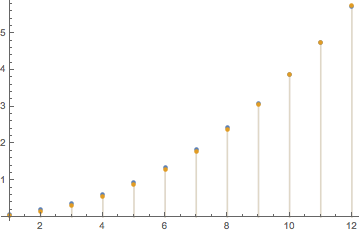The following very nasty question came up in my physics homework this week:
Given two configurations, $C_1$, $C_2$ of $N$ point charges each determine the value of $N$ s.t. $U_1=U_2$.
$C_1$: $N$ point charges are uniformly distributed on a ring s.t. the distance between adjacent electrons is constant
$C_2$: $N-1$ point charges are uniformly distributed on a ring s.t. the distance between adjacent electrons is constant and one charge is placed in the center of the ring.
Crazy Solution
Let $N$ charges be arranged along a circle with radius $R$. The position of an arbitrary particle at an angle $\theta$ relative to the positive direction of the x-axis is $\vec{P}(\theta) = (R\cos\theta, R\sin\theta)$. Pick one charge located at angle $\theta = \theta_i$ and another particle located at $\theta = \theta_j$ relative to the positive direction of the x-axis. The distance between the two particles $\vec{r}$ is
Where
We get
With this expression for $\vec{r}$, we can write the net potential energy for particle $j$ along the circle with the equation assuming all particles have charges $q$
For concision, let
Then net potential energy can be expressed as
For two configurations with $N$ charges we define the potential energies:
where the second term in the definition of $U_2$ determines the potential for the lone particle in the center.
Now we solve for the $N$ at which $U_1 = U_2$
Which is really difficult to solve directly. But we can compute solutions:
f[N_] = Sum[Csc[j*Pi/N], {j, 1, N - 1}]*1/(8*Pi)
DiscretePlot[{i/2*f[i] + i/(4*Pi), (i + 1)/2*f[i + 1]}, {i, 1, 12}]
And see the solution is for $N=12$

